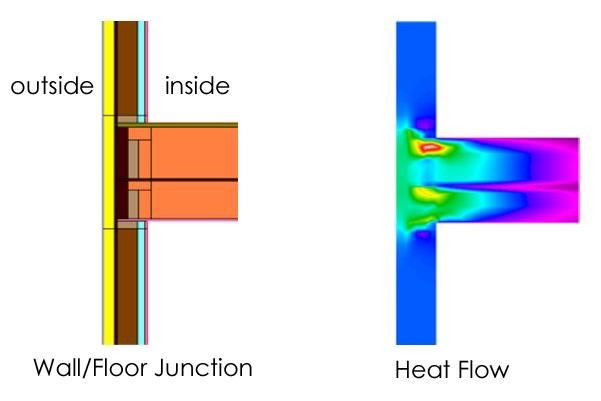Thermal Break vs Thermal Bridge - In Buildings & Windows
Thermal Bridge vs Thermal Break
If you’re new to building science these terms may seem esoteric but hopefully you will come to a better understanding of them after reading this.
Think of the term thermal as HEAT.
Think of term bridge (in thermal bridge) as a connection between point A and point B - which is what an actual bridge is. So thermal bridge is simply the act of heat transporting through or on the “bridge” from point A to point B.
Think of the word break (in thermal break) as in shutting down a lane of traffic on that “bridge.” Now it’s a one lane road, cars are going much slower and there is a greatly reduced number of vehicles crossing. During peak hours more cars might travel through then other times of the day. But nonetheless there has been a great interruption.
In terms of heat transfer (or thermal bridge), once a thermal break is incorporated, heat (and cold) has a much harder time traveling from point A to point B.
 |
| Heat/Cold Only Transfer In/Out of the House Where the Concrete Balcony is... AKA THERMAL BRIDGE. The Pink Signifies the Exterior Insulation Layer |
Now for More Technical Definitions
Thermal bridge (or bridging) refers to the act of heat conducting (traveling) through an object and bypasses insulation. It is also a path for cold to make its way inside during cold months. Energy takes the path of least resistance, so materials that are highly conductive will be the easier path.
Thermal break refers to the act of adding a low-conductive material to reduce or interrupt the flow of energy, ie: heat or cold.
Why Thermal Bridging Matters
It’s the silent degrader for a house’s thermal efficiency. Most people don’t realize that this is a primary contributing factor as to why their house gets so hot during summer months. The sun heats up the exterior cladding, which then that energy transfers to the sheathing and then to the studs and finally to the interior wall surface and into a homes conditioned space. Obviously poor glazing (windows) play a major role into solar heat gain as well but that is not what we are focusing on here.
This transfer of energy makes a house less efficient because it adds unnecessary heat (during hot months) and let’s heat escape out of the house (in colder months). Cold can also make its way into a building envelope through a steel beam or aluminum framed window and cause condensation. In simple terms, a thermal bridge makes a home less efficient and less resilient.
 |
| As You Can See Heat Flows Through Materials into a Home's Conditioned Space |
Incorporating thermal breaks
In a building envelope, the most common way to include a thermal break is by adding a layer of continuous insulation on the outside of the sheathing (think down jacket). There are some “weak” spots where continuous insulation is more difficult to accomplish. For example, at structural points like roof to wall connections (aka parapet), balcony to wall penetrations and all other interfaces. So extra care will be needed in order to add thermal breaks in those locations. The architect should specify these details to execute them successfully.
 | ||
|
 |
| Thermal Break Added at Balcony to Wall Junction |
In windows, a thermal break is added to frames made of highly conductive material such as aluminum and steel. Without a thermal break in windows made of these materials, the interior side of the frame could very well be the same temperature as the outside frame temperature. That’s bad news for all times but especially during peak summer/winter months. If you have ever lived in a home with old aluminum windows, you know exactly how bad this can be. It can be hot to the touch after it’s been sitting in the sun all day… or you could wake up to a puddle of water sitting on the window frame and stool after a long winters night (for more on why condensation occurs on the inside of windows, read my blog post on it HERE).
In regards to a window opening, they are also a common thermal bridge location. This is because they are 1) often attached directly to the wood framing/sheathing & 2) the glass is typically not in the same plane as the insulation layer. To combat this thermal bridge, high performance homes ensure the glass is aligned with the insulation layer, whether that is in the middle of the wall (innie install) or with the external continuous insulation layer (outie install). If an outie install is called for, Thermal Bucks are a great way to increase the window opening (and overall wall) efficiency as it provides a true continuous insulation layer and thermal break.
 |
| "Innie" Window Install - Middle of Wall |
 |
| "Outie" Window Install & Utilizing THERMAL BUCK for a TRUE Continuous Insulation Layer |
Conclusion
Hopefully you now understand the building science terms “thermal break” and “thermal bridge.” 99% of homes have thermal bridges, a lot more in recent years are incorporating thermal breaks on higher performing houses and only a minority of houses (for now) ONLY have thermal breaks, AKA no thermal bridges. Those houses are called passive houses and one of the core tenants of a passive house is a thermal bridge FREE envelope, among other things related to home efficiency.
Please feel free to reach out if you have any questions pertaining to the differences.

.JPG)


Comments
Post a Comment